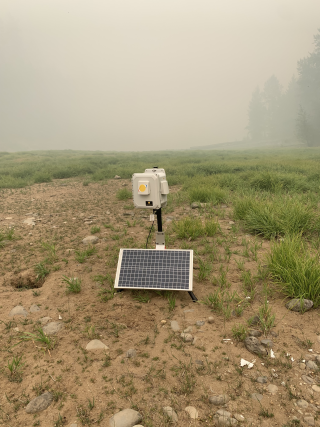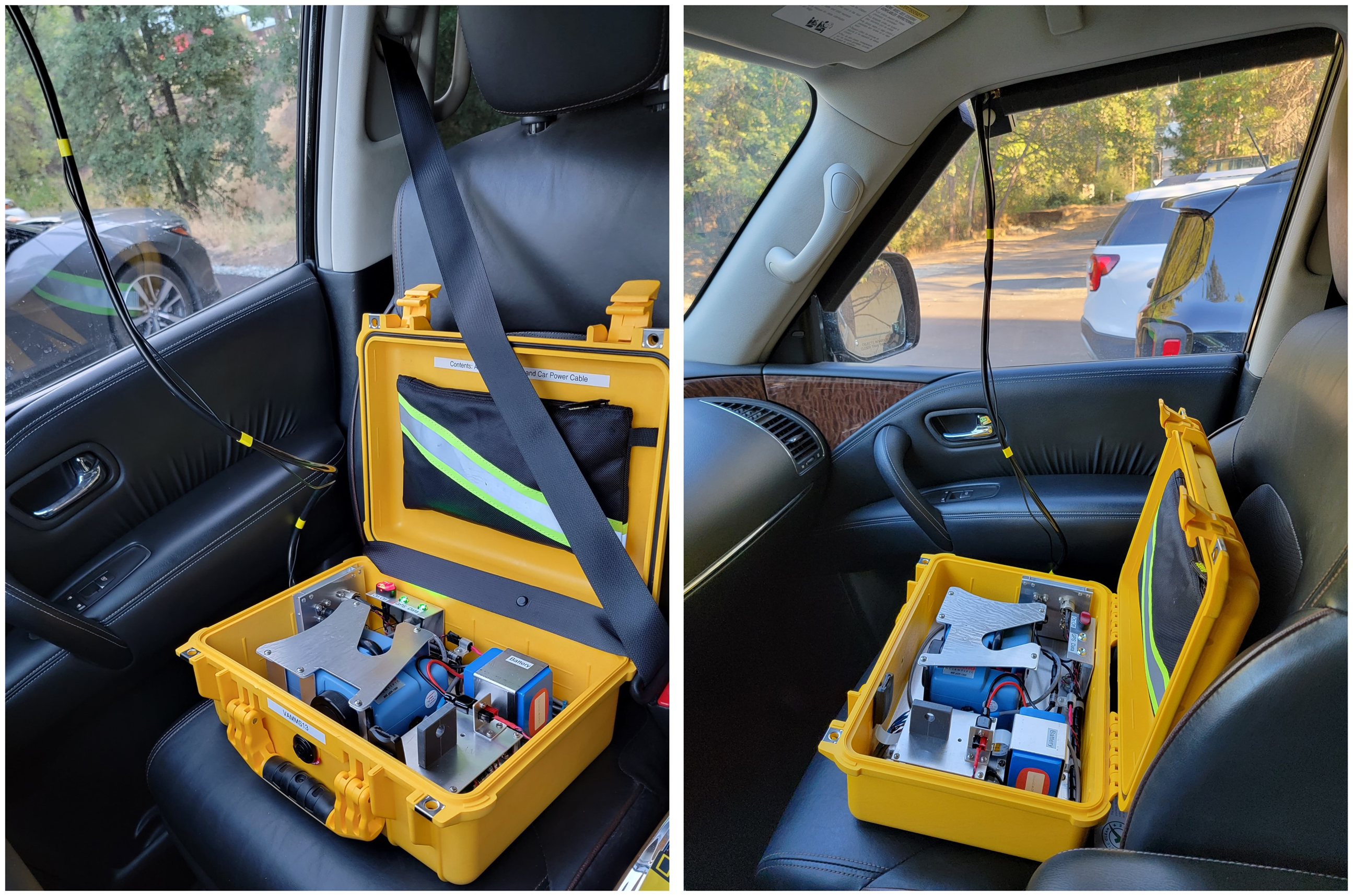Wildfire Smoke Air Monitoring Response Technology (WSMART)

EPA is loaning specific air monitoring technologies to state, local, and Tribal air organizations to support supplemental air monitoring in areas that experience wildfire smoke and with observational data coverage gaps.
On this page:
- WSMART Loan Program
- Equipment Available for Loan
- Frequently Asked Questions
- Publications
- Related Links
WSMART Loan Program
The Wildfire Smoke Air Monitoring Response Technology (WSMART) loan program is part of a federal government response to address the growing threat of wildfires and related smoke impacts that are a public health concern in the United States. In many areas affected by wildfire smoke, air monitoring data may be limited or absent. Supplemental monitoring technologies can help air monitoring organizations gather timely data to assess smoke impacts and provide public health information.
The primary measurement of the supplemental technologies is fine particulate matter (PM2.5), with carbon monoxide (CO), total volatile organic compounds (tVOCs), and black carbon also measured in some systems. The current systems that are available upon request are two stationary units – a PM2.5 sensor and multipollutant sensor (PM2.5, CO, tVOCs) system – and a portable system called the Vehicle Add-on Mobile Monitoring System (VAMMS).
Equipment Available for Loan
Disclaimer: Mention of trade names or commercial products does not constitute EPA endorsement or recommendation for use.
PM2.5 Sensor
-

Multipollutant sensor system available through WSMART - Outdoor or indoor use
- Plug-in to outlet for power
- Requires WiFi to transmit data for public display
- Note: This option will be discontinued after available units are loaned. See FAQs for more information.
Multipollutant Sensor System
- Stationary sensor system made by Outpost Environmental that measures three pollutants: CO, tVOCs, and PM2.5
- Outdoor use
- Solar and battery powered
- Cellular data telemetry
Vehicle Add-on Mobile Monitoring System (VAMMS)
- Compact monitoring system that utilizes a Thermo Scientific pDR-1500 to measure PM2.5 and a CO sensor, measuring at a high time resolution
- A limited number of expanded VAMMS systems (VAMMS-X) will include an additional measurement of black carbon
- Global positioning system (GPS) to log location
- Microprocessor for data integration
- Window probe mount attaches to any vehicle
- Monitors outside air
- Battery powered

Eligibility: State and local air agency monitoring staff; Professional Tribal air quality staff members. The equipment is not available for general public use.
Training: EPA will provide technical support information along with the loaned air monitors and provide remote troubleshooting support. The VAMMS’ data can be interactively viewed on the RETIGO data visualization system, along with training materials.
Additional information: EPA covers the cost of shipping to location and return to EPA.
Frequently Asked Questions
Will EPA provide Standard Operating Procedures (SOPs) or other supporting information?
Yes. For loaned equipment, EPA will provide supporting technical information such as quick start guides and SOPs.
Can my organization keep the monitors loaned?
The PM2.5-only sensors loaned, while supplies last, can be requested for retention. The VAMMS and multipollutant sensor systems cannot be retained permanently and are tracked federal property.
What happens if a monitor is damaged or stolen?
EPA loans the equipment with the understanding it is going into potentially severe air pollution scenarios and there are inherent risks to equipment when used in the field. If damage or other equipment issues occur, EPA will request explanation for what occurred and will repair/replace to the extent resources allow.
Are there any limitations regarding where these units could be operated? Can my organization loan this unit to another group?
The use of the monitors should be for supplemental and informational air quality monitoring purposes related to wildfire smoke response. The recipients have flexibility regarding where the monitors are utilized to collect data to best meet their goal. The recipients cannot officially transfer a federal property loan, but can collaborate with local partners (e.g., community groups, municipalities) on the measurement locations and request local partner participation in the data collection.
Are the data from these monitors public?
The PurpleAir data are posted on the web by the vendor and will post publicly to the Fire and Smoke Map on the EPA-managed AirNow.gov website after undergoing quality assurance and bias adjustments built into that data platform. Please refer to the FAQs on the Fire and Smoke Map for more information. The multipollutant sensor will not report data publicly. Instead, the data will be available to EPA and the recipient via a private access data platform. The VAMMS data will not report data publicly. The data are stored to onboard memory.
Does EPA want the air organization borrowing the equipment to share the data?
EPA can directly access data for PurpleAir and Outpost Environmental multipollutant sensor. EPA would like to receive VAMMS data to develop a data archive that can be used to improve the system in the future and for other research uses. For those requesting VAMMS systems, EPA staff will reach out to create a low-time burden approach to share data.
Can I request this equipment to try out during periods of low wildfire activity?
During periods with lower wildfire activity nationwide, state, local, and Tribal air organizations can request a loan of the monitors for up to a three-month period under an equipment testing partnership. In this arrangement, the recipient can try out the monitoring equipment and use it to collect data in other smoke measurement applications (e.g., prescribed fire). The WSMART technical team will be interested in user feedback from these partners and collected data to support ongoing research and development activities. For requests of this nature, please specify in the comments of the request form that this is an equipment testing partnership request and the preferred time window of your loan.
The website indicates that WSMART may discontinue loaning the PM2.5 sensor in the future – why is this?
The WSMART research team has ongoing engagement with air monitoring professionals and optimizes the limited resources in this program toward meeting key monitoring gaps. Because newly established air sensor loan programs are available to provide the PM2.5-only sensor and as these are commercially available, WSMART will focus primarily on stationary and mobile air monitoring technologies that are less available through other options. In 2024, WSMART plans to loan out the remaining PM2.5 sensors in inventory and will continue providing technical support to prior loan recipients who retained their sensor for longer-term use, as resources allow.
I am interested in using air sensors for other purposes not related to wildfire smoke. Are there other resources available?
EPA has several other air sensor loan programs currently active. Visit our Air Sensor Loan Programs webpage for information on other air sensor loan programs in your area and additional air sensor resources.
Publications
Bittner, A., A. Holder, A. Grieshop, G. Hagler, AND W. Mitchell. Performance of Vehicle Add-on Mobile Monitoring System PM2.5 measurements during wildland fire episodes. Environmental Science: Atmospheres. Royal Society of Chemistry, Cambridge, Uk, 4(3):306-320, (2024).
